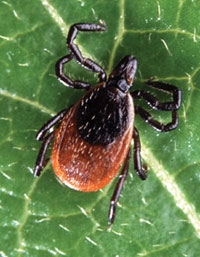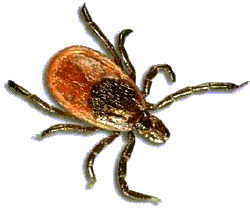
Ixodes
tick. Photo by Scott Bauer |
A
recent study suggests that suburban sprawl leading to forest fragmentation
could also increase the prevalence of ixodid ticks infected with Borrelia
burgdorferi, the spirochaete bacterium that causes Lyme disease
(K. LoGiudice et al., "The ecology of infectious disease: Effects
of host diversity and community composition on Lyme disease risk,"
Proc Nat Acad Sci, 100:567-71, Jan. 21, 2003). Ixodid ticks
become infected as nymphs by taking a blood meal from an infected
animal, especially from the white-footed mouse, Peromyscus leucopus.
|
To devise a model for
the presence of Borrelia-infected ticks, the researchers sampled
bird and mammalian hosts, counting how many blood-engorged tick larvae
fell off each animal. They then determined how many larvae were infected.
Using these and other
data, researchers constructed a mathematical model of the effects of biodiversity
on tick infestations. The model suggests that in habitats where there
are more potential species of tick hosts, tick larvae are less likely
to become infected because some of these hosts have low-reservoir competence;
that is, even if bitten by an infected tick, the species either is unlikely
to become infected or unable to pass on the infection.
"Forest fragmentation,"
the authors noted, "decreases mammalian biodiversity and results
in areas of very high mouse density." Kathleen LoGiudice of Union
College in Schenectady, NY, says "sprawling development ... may be
increasing our exposure to Lyme and similar vector-borne diseases. Biodiversity
can have some very real implications for our health and quality of life."
The
ecology of infectious disease: effects of host diversity and community
composition on Lyme disease risk.
LoGiudice K, Ostfeld RS, Schmidt KA, Keesing F. Institute of
Ecosystem Studies, Box AB, Millbrook, NY 12545, USA.
The extent to which the biodiversity and community composition of ecosystems
affect their functions is an issue that grows ever more compelling as
human impacts on ecosystems increase. We present evidence that supports
a novel function of vertebrate biodiversity, the buffering of human risk
of exposure to Lyme-disease-bearing ticks.
We tested the Dilution Effect model, which predicts that high species
diversity in the community of tick hosts reduces vector infection prevalence
by diluting the effects of the most competent disease reservoir, the ubiquitous
white-footed mouse (Peromyscus leucopus). As habitats are degraded
by fragmentation or other anthropogenic forces, some members of the host
community disappear.
Thus, species-poor communities tend to have mice, but few other hosts,
whereas species-rich communities have mice, plus many other potential
hosts. We demonstrate that the most common nonmouse hosts are relatively
poor reservoirs for the Lyme spirochete and should reduce the prevalence
of the disease by feeding, but rarely infecting, ticks.
By accounting for nearly every host species' contribution to the number
of larval ticks fed and infected, we show that as new host species are
added to a depauperate community, the nymphal infection prevalence, a
key risk factor, declines.
We identify important "dilution hosts" (e.g., squirrels), characterized
by high tick burdens, low reservoir competence, and high population density,
as well as "rescue hosts" (e.g., shrews), which are capable
of maintaining high disease risk when mouse density is low. Our study
suggests that the preservation of vertebrate biodiversity and community
composition can reduce the incidence of Lyme disease.
Full text: Proc
Natl Acad Sci U S A. 2003 Jan 21;100(2):567-71. Epub 2003 Jan 13
|

